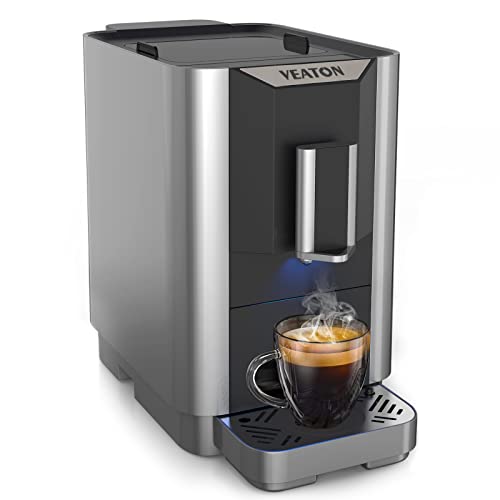Ten Espresso Machine Coffee-Related Stumbling Blocks You Should Never …
페이지 정보
작성자 Stepanie 날짜25-02-21 19:21 조회2회 댓글0건본문
How to Make Espresso Machine Coffee
 automatic espresso machine machines can make a delicious cup, but they require more maintenance and setup than a regular coffee machines espresso maker. You'll also need to grind and tamp the beans by yourself.
automatic espresso machine machines can make a delicious cup, but they require more maintenance and setup than a regular coffee machines espresso maker. You'll also need to grind and tamp the beans by yourself.
The key to making espresso is pressure. Here's how an espresso machine works: a heating vessel is used to heat water to a suitable temperature, and then pushes it through the grounds before pouring out the spouts.
Temperature
espresso coffee machines for sale is made by forcing hot water under pressure through finely ground coffee. The temperature of the water is critical to the quality of the final shot. Low temperatures can cause absence of flavor compounds. The high temperatures cause excessive extraction and can lead to burnt or bitter flavors.
The ideal temperature for espresso is between 195 and 205degF. This temperature can be achieved by using a grouphead designed to ensure a constant temperature and stability throughout the brewing process. The E61 is the most sought-after group head, as it provides temperature stability, pre-infusion capabilities, and lever control.
It is important to take into account the temperature when adjusting your espresso machine to different roasts or brew ratios. This will impact the extraction yield as well as the crema. The ideal temperature will vary depending on the roast and the bean. However it is a general rule that lighter roasts with higher brew speeds require higher temperatures. A reliable thermocouple is essential for maintaining the same temperature.
Pressure
During the brewing process espresso machine coffee is pressure-pushed through finely ground and tamped coffee grounds. This triggers chemical reactions which extract flavors oils, flavors and other soluble ingredients from the beans. The resultant drink is usually more flavorful and richer than regular coffee.
The ideal espresso machine's pressure is nine bars of pressure that's the same as the atmospheric pressure at sea level. The soluble compounds found in the espresso bean are best espresso machine uk; sneak a peek at this website, extracted at this pressure.
However some espresso machines advertise 15 or 20 bars of pressure. These machines might be able to attain these pressure levels but they may not maintain them throughout the extraction.
To put it in perspective, one bar of pressure is equivalent to 32 pounds per square inch PSI of a car tire. It's four times the amount of pressure that a professional cyclist uses when pumping up their bike tires. Any serious home barista has to be able control the pressure of their espresso machine and make consistent espressos.
Water
The water you use to make espresso is among the most crucial elements of a great cup coffee. The correct water will allow your beans to reach their full potential, while the wrong water can lead to problems such as clogged pipes or even damage your expensive espresso machine.
The best option is natural spring water that is high in minerals for ideal espresso extraction. This water will enhance the taste of your espresso without the mineral chalky trace found in tap water or bottled water. This is a great alternative to reverse osmosis. It can be too pure and cause problems with flavor.
However, you should never use a water filter that removes excessive minerals from the tap water, as this can also cause problems with flavor and extraction. Buy a water testing kit to determine the average hardness of your water at the local level. This can then be used to locate the best filtration system to provide the proper water specifications for your espresso machine.
Beans
Most coffee espresso machines drinkers tend to be very involved in the entire process of making espresso. They are obsessed with a variety of variables, best espresso machine uk including temperature, water pressure beans, milk viscosity and other factors. If one of the variables is slighty off, the entire shot might taste bad.
The most important aspect when it comes to espresso is the beans used. Many people believe that only certain varieties are suitable for espresso. While some beans are better suited for certain purposes, any roasted bean can be used to make espresso. The difference between espresso beans and regular coffee beans is that espresso beans are roast for longer and tipycally over the second crack, which gives them more of a dark appearance and makes them more water-soluble.
The best espresso beans tend to be medium or dark roasted, which give the shots their characteristic richness and boldness. However, it is also possible to make great espresso with light roasted beans, especially if the beans are preground (for convenience in an espresso machine).
Milk
Espresso and milk is a classic pairing. The combination of espresso and milk is an iconic. Not only does it boost energy, but it also balances the bitterness in the espresso. There aren't many culinary combinations more perfect than this!
If you decide to purchase an espresso machine that can make cappuccino or latte make sure to consider how easy it is to use. A majority of the top espresso machines include a jug to drink hot or cold milk as well as a steam wand. They also come with an espresso portafilter that can be used to make the shot. Certain models have a built in grinder, tamper and frother.
The steam wand should be purged before using it for the first time each day (or after every cup of espresso) to remove any water that has condensed. The process takes only 30 seconds, but it's vital to keep your machine running smoothly. If you don't flush the system, it could cause a bitter taste and/or a accumulation of bacteria that could alter the taste or odor of your beverage. It's not difficult to do and should form part of your routine maintenance routine.
 automatic espresso machine machines can make a delicious cup, but they require more maintenance and setup than a regular coffee machines espresso maker. You'll also need to grind and tamp the beans by yourself.
automatic espresso machine machines can make a delicious cup, but they require more maintenance and setup than a regular coffee machines espresso maker. You'll also need to grind and tamp the beans by yourself.The key to making espresso is pressure. Here's how an espresso machine works: a heating vessel is used to heat water to a suitable temperature, and then pushes it through the grounds before pouring out the spouts.
Temperature
espresso coffee machines for sale is made by forcing hot water under pressure through finely ground coffee. The temperature of the water is critical to the quality of the final shot. Low temperatures can cause absence of flavor compounds. The high temperatures cause excessive extraction and can lead to burnt or bitter flavors.
The ideal temperature for espresso is between 195 and 205degF. This temperature can be achieved by using a grouphead designed to ensure a constant temperature and stability throughout the brewing process. The E61 is the most sought-after group head, as it provides temperature stability, pre-infusion capabilities, and lever control.
It is important to take into account the temperature when adjusting your espresso machine to different roasts or brew ratios. This will impact the extraction yield as well as the crema. The ideal temperature will vary depending on the roast and the bean. However it is a general rule that lighter roasts with higher brew speeds require higher temperatures. A reliable thermocouple is essential for maintaining the same temperature.
Pressure
During the brewing process espresso machine coffee is pressure-pushed through finely ground and tamped coffee grounds. This triggers chemical reactions which extract flavors oils, flavors and other soluble ingredients from the beans. The resultant drink is usually more flavorful and richer than regular coffee.
The ideal espresso machine's pressure is nine bars of pressure that's the same as the atmospheric pressure at sea level. The soluble compounds found in the espresso bean are best espresso machine uk; sneak a peek at this website, extracted at this pressure.
However some espresso machines advertise 15 or 20 bars of pressure. These machines might be able to attain these pressure levels but they may not maintain them throughout the extraction.
To put it in perspective, one bar of pressure is equivalent to 32 pounds per square inch PSI of a car tire. It's four times the amount of pressure that a professional cyclist uses when pumping up their bike tires. Any serious home barista has to be able control the pressure of their espresso machine and make consistent espressos.
Water
The water you use to make espresso is among the most crucial elements of a great cup coffee. The correct water will allow your beans to reach their full potential, while the wrong water can lead to problems such as clogged pipes or even damage your expensive espresso machine.
The best option is natural spring water that is high in minerals for ideal espresso extraction. This water will enhance the taste of your espresso without the mineral chalky trace found in tap water or bottled water. This is a great alternative to reverse osmosis. It can be too pure and cause problems with flavor.
However, you should never use a water filter that removes excessive minerals from the tap water, as this can also cause problems with flavor and extraction. Buy a water testing kit to determine the average hardness of your water at the local level. This can then be used to locate the best filtration system to provide the proper water specifications for your espresso machine.
Beans
Most coffee espresso machines drinkers tend to be very involved in the entire process of making espresso. They are obsessed with a variety of variables, best espresso machine uk including temperature, water pressure beans, milk viscosity and other factors. If one of the variables is slighty off, the entire shot might taste bad.
The most important aspect when it comes to espresso is the beans used. Many people believe that only certain varieties are suitable for espresso. While some beans are better suited for certain purposes, any roasted bean can be used to make espresso. The difference between espresso beans and regular coffee beans is that espresso beans are roast for longer and tipycally over the second crack, which gives them more of a dark appearance and makes them more water-soluble.
The best espresso beans tend to be medium or dark roasted, which give the shots their characteristic richness and boldness. However, it is also possible to make great espresso with light roasted beans, especially if the beans are preground (for convenience in an espresso machine).
Milk
Espresso and milk is a classic pairing. The combination of espresso and milk is an iconic. Not only does it boost energy, but it also balances the bitterness in the espresso. There aren't many culinary combinations more perfect than this!
If you decide to purchase an espresso machine that can make cappuccino or latte make sure to consider how easy it is to use. A majority of the top espresso machines include a jug to drink hot or cold milk as well as a steam wand. They also come with an espresso portafilter that can be used to make the shot. Certain models have a built in grinder, tamper and frother.
The steam wand should be purged before using it for the first time each day (or after every cup of espresso) to remove any water that has condensed. The process takes only 30 seconds, but it's vital to keep your machine running smoothly. If you don't flush the system, it could cause a bitter taste and/or a accumulation of bacteria that could alter the taste or odor of your beverage. It's not difficult to do and should form part of your routine maintenance routine.
댓글목록
등록된 댓글이 없습니다.



















 광송무역
광송무역
 070-7762-8494
070-7762-8494

